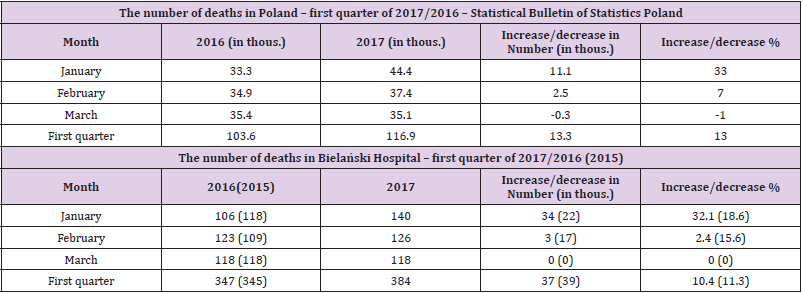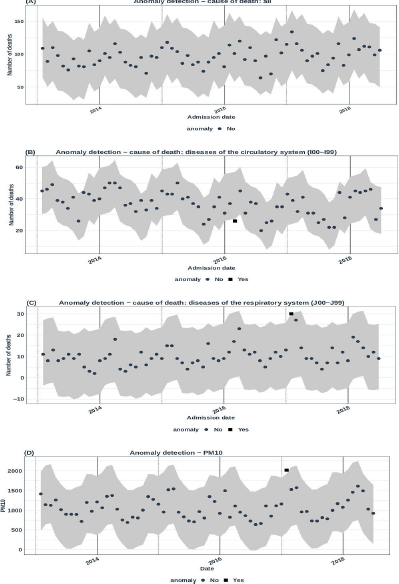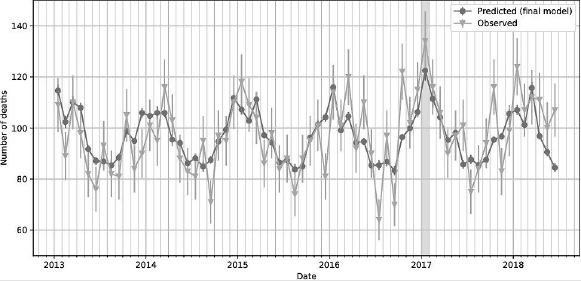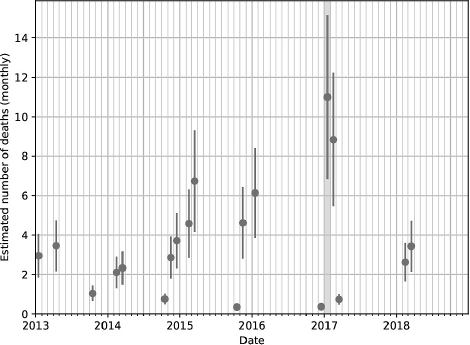Positive Association Between Short-Term Exposure to High Concentration of Particulate Matter and in Hospital Mortality
Introduction
According to Statistics Poland (GUS) report for the first quarter of 2017, about 13,3 thousand (13%) more deaths were registered in this period than in the corresponding period of 2016 (Table 1) [1]. This was confirmed and elaborated by data published by the National Health Fund (NHF) in 2018 [2]. The analyses conducted showed that in January 2017 the number of deaths in Poland increased by 23.5% compared to January 2016 (number of deaths in this analysis was corrected for age standardized death rate per 100,000 residents, relative to the structure of society in 2010). In the discussed period, lower temperatures were recorded in Poland than in the corresponding months of previous years, as well as extremely high concentrations of PM10 particulate matter in most of the country, reaching an average of 80 μg/m3, were noticed [2]. Research in the United Kingdom, Germany, Spain, the United States and Brazil showed that an average increase in particulate matter of 10μg/m3 increases hospital visits by 1-4% and early all-cause deaths by 0.5–1.5%, which are delayed by 1-2 days in relation to unfavourable aero-sanitary conditions [3,4].
The later effects of such anomalies distributed over subsequent years are quantitatively difficult to estimate. Based on conducted research, it is also believed that in cities with high concentrations of suspended particulates, the risk of death is 15-25% higher than in cities with low particulate pollution [3]. A report by the WHO (2002) states that 800,000 premature deaths of people per year are caused by air pollution [4]. Recently Liu et al. showed that 10μg/m3 increase in mean particulate matter (PM) air concentration causes a 0.44% higher short-term all-cause, a 0.36% higher cardiovascular and 0.47% higher respiratory mortality [5]. Since January 2013, the causes of in-hospital deaths have been analysed in the hospital [6]. The analysed data consists of thousands of patient cases in the form of death records and their causes extracted from the Electronic Health Records (EHR) database. The analyses showed an increase in the number of deaths in January 2017 compared to previous years (Table 1). This study allowed us to examine and compare the association of PM10 air concentration and temperature with allcause, cardiovascular and respiratory mortality in the hospital.
Material and Methods
Bielański Hospital is one of the largest multi-profile hospitals in Warsaw with its own Emergency Department (ED) and about 600 beds, with approximately 100,000 patients hospitalized every year. The analysed data consisted of cases of patient deaths of persons who were admitted to the hospital between January 1, 2013 and June 30, 2018. All medical patient data, including records indicating the causes of death, are stored in the EHR database. Prior to the analysis, all data used for this study were thoroughly anonymized by the Information Technology department of the hospital, so that no personal information was available to the data analysts from the NCBJ. Moreover, all data processing was performed on a dedicated server located inside the hospital. Between January 2013 and June 2018, 6783 death cases were recorded in the EHR of the hospital. For the analysis, we considered only death cases that began as emergencies, i.e. the patient was admitted resulting from a decision made by ED personnel. This requirement was met by 95.7% of cases. Air temperature data was obtained from the archive of meteorological reports of the local, closest to the hospital, weather station [7].
Air pollution data was retrieved from the Polish Chief Inspectorate of Environmental Protection [8]. We used the daily recorded PM10 averages from the measurements performed by the two stations closest to the hospital (with distance to the hospital of 1 and 6.3 km). The reason we concentrated on PM10 levels and not PM2.5 in our analysis is that only PM10 data were available with full coverage for the period under study. For the sake of the analysis, measurements from both stations were averaged for any given day. In cases when only data from a single station were available, this measurement was used instead of the average. There were no analysed days for which data was missing simultaneously from both stations.
Statistical Analysis
An analysis of the anomalies of the variable describing the distribution of deaths over time was conducted on hospital data to determine whether there was an increased number of deaths in the hospital in January 2017 compared to January 2016, as was reported in the nationwide data [1]. To assess the statistical significance of this effect we performed an anomaly detection analysis using the anomalize R library [9]. For this analysis, we used the Seasonal Decomposition of Time Series by Loess (STL) [10] algorithm for decomposing the time series data representing the number of deaths into the trend and seasonality, and the Generalized Extreme Studentized Deviate Test (GESD) [11] for finding anomalies in the remainders. In order to find a possible reason for the increase indeed seen in the data, we used the registered initial cause of death to try to identify which classes of ICD-10 codes contributed significantly to the data of the 2016/2017 winter. Two classes of causes of death were considered: respiratory and cardiovascular, corresponding to Chapters X and IX of the ICD-10 classification. Next, an identical analysis of the anomalies was also performed for the variable describing the concentration level of PM10 particulates in the air.
A cross-check analysis of the anomalies of the number of deaths categorized by the above-mentioned causes was also performed using permutation tests [12]. Next, a generalized linear model with the response variable errors modelled with Poisson distribution was constructed in an attempt to explain the confirmed number of deaths by the ambient temperature, and then the results of this model were compared with another linear model, in which apart from ambient temperature, air pollution levels were also taken into account.
Results
The results of this analysis are presented for all, respiratory and cardiovascular classes defined above (Figures 1A-1C). The analysed data allow to set a threshold of significance level of the anomaly equal to 10-4, which is illustrated by the grey area in the presented figures. The algorithm identifying anomalies found an excess number of deaths caused by respiratory system diseases at the 10-4 significance level in January 2017, while no excess deaths at this level of significance were noted for those relating to cardiovascular causes. To try to find the reason for this excess of deaths caused by respiratory system diseases, we looked at the registered PM10 air pollution data. We used the same algorithm with the same parameters to search for anomalies in these data (Figure 1D). At the 10–4 significance level, an anomaly was found in January 2017, coinciding with the excess number of deaths caused by respiratory system diseases. In order to gain a better understanding of the anomalies detected with the STL/GESD algorithm, additional verification was performed using permutation tests.
Observed number of deaths for each month was compared to data from a similar period observed in the remaining years over a 3-month window. In such approach January 2017 yet again was considered the most anomalous month within the respiratory-related category (with p-value = 0.000064). Moreover, it was observed, that when considering all deaths excluding the respiratory-related ones, January 2017, with p-value=0.154, can by no means be considered anomalous. Therefore, we conclude that the January 2017 excess was caused by respiratory systemrelated deaths. As the next step of the analysis, we decided to check the correlation of the number of deaths with the average daily temperature as this is a well-known effect [3]. We wanted to determine if this effect alone was enough to explain the presented anomaly. In order to do so, a generalized linear model with the response variable errors modelled with Poisson distribution was constructed, linking average daily temperature to the observed number of deaths on a given day.
For each considered case of death, the hospital admission date is used, since time of death approach resulted in a significantly worse data description. The model was constructed using the Maximum Likelihood method and allowed us to calculate the monthly onesided p-values. A low p-value indicates that the observed excess in the number of deaths in a given month is inconsistent with the obtained model, i.e. it should be considered anomalous. The lower the obtained p-value for a given data point is, the more anomalous it should be considered. In such approach, January 2017 is still the most anomalous month, with a p-value of 0.014. Therefore, we conclude that the average daily air temperature alone is not enough to explain the excess of deaths in January 2017. The next step was to consider the model utilizing both temperature and air pollution as input variables. Because there is no known direct mechanism of the impact of air pollution on the human body, the model included the possibility of its interaction within a certain time interval, which remained a free parameter of the model.
In addition, we decided to take into account the possibility that air pollution affects the observed number of deaths only after exceeding a daily threshold of 50 μg/m3, corresponding to the threshold set by EU on daily PM10 mean [13]. Optimal input variables transformations (e.g. window sizes) and models (i.e. the variable sets) were selected using the grid search method and Akaike Information Criterion (AIC) [14]. The best-performing model (the final model) utilized the following variables: 5 days windowed daily air temperature with 12 days of delay 8 days windowed PM10 air pollution average with a threshold of 50 μg/m3 applied after calculating the windowed average The second-best model, utilizing only the windowed temperature-based variable, was rejected, since the Akaike probability that this model does in fact better describe the data than the final model was only 0.077.
Monthly predictions of the average number of deaths obtained with the final model are shown in Figure 2. The observed monthly numbers of deaths are provided for comparison. It can be seen that the predictions of the final model follow the observed values. In the windowed temperature-only based model (i.e. the rejected, second-best model), the p-value obtained for January 2017 (0.02) stops being the most extreme, but is still small (i.e. this month still could be considered anomalous with respect to this model). On the contrary, the p-value obtained with the final model for the same month (0.3) does not allow this month to be considered anomalous any more. Therefore, we conclude that the excess of deaths observed in January 2017 is explained by the observed air temperature and excessive air pollution levels. As the final result, we present the monthly estimated numbers of deaths caused by air pollution (Figure 3). In order to calculate the values shown, the difference was determined between the final model-obtained values presented in Figure 2 and the final model predictions, when applied to the input data with the air pollution-related values zeroed.
The estimated, with the final model, mean number of air pollution-related deaths for the period of January 2017 is 11.1 ± 4.1, which is 8.3% of all deaths observed in that period if the date of hospital admission is taken as the time variable. The total number of air pollution-related deaths in the whole analysed period (January 2013 - June 2018) is estimated to be 70 ± 26, which is 1.1% of all observed deaths in the whole analysed period.
Discussion
The analysis broadens the conclusions presented in the Statistics Poland and NHF reports suggesting a connection between the observed number of deaths with low temperature and high air pollution, confirming at the same time the relationship between high PM10 concentrations in the air and the increased deaths in January 2017, especially those associated with respiratory diseases. It seems that a characteristic feature of the period with the significantly higher number of deaths registered by GUS (January 2017) was the persistence of air pollution levels at a very high level over an exceptionally long (up to ten days) time period without interruptions that would have allowed the body to regenerate, especially in the case of people particularly susceptible to respiratory disorders. It is also important to note that the key aspect of the analysis was to use the emergency hospital admission date as the time variable, not the date of in-hospital death.
One can speculate that the admission date was the same time as the moment the patient was isolated from the adverse impact of the atmosphere: low temperature and air pollution, as well as from the chemical agents accompanying the contamination of the suspended PM. This construct has also ruled out the influence of the hospital environment, which, especially with the elderly and chronically ill, can be an additional risk factor. The study authors and observers of the effects of air pollution emphasize that its short-term effect is observed within hours, and at most days, from the observed contamination [15-17]. The increase in the number of hospitalizations and deaths due to cardiovascular and pulmonary causes was observed both in short and longer time ranges [15-19]. The literature contains comparative analyses of the influence of pollution found inside homes with outdoor air pollution [15,16]. These studies show that the use of air filters in homes reduced the concentration of pollutants by 60-70%, which was accompanied by a significant improvement in vascular endothelial function, after just two days of isolation from the contaminated air [16,20]. This was connected to a change in the influence of inflammatory reactions arising from exposure to air pollution components. It should be emphasized that, until recently, both: the information level about PM10 pollution and alarm level were liberal in Poland when compared to the standards applied in the vast majority of other European countries. Standards for PM10 are set based on the average daily value. In Poland, a level not exceeding 50 μg/ m3 was considered acceptable, whereas the information level was set at 200 μg/m3, and the alarm level at 300 μg/m3, while in most EU countries, the alarm level is set below 150 μg/m3 [21]. In this context, it is interesting to note that on the one hand, the data presented in the analysis best explained the models which assumed that only after exceeding a threshold of 50 μg/m3 for the daily average value of PM10, air pollution affects the number of deaths observed, but on the other hand, this value is several times lower than the alarm value adopted in Poland for the analysed period (300 μg/m3). Recently, the alarm and information levels in Poland were lowered to 150 μg/m3 and 100 μg/m3 respectively [22].
Considering that the best explanations for the anomalies in the increased number of deaths were those models that assumed an already exceeded threshold of 50μg/m3 for the average daily value of PM10 air pollution influences the observed number of deaths, it seems reasonable to take early precautionary measures to isolate patients from air pollutants at levels lower than the current PM10 alarm levels. Has recently been shown to affect mortality also in low PM concentrations, below the current air-quality guidelines, which confirms earlier suggestions that there are no safe thresholds for particulates matters [5,23]. It is also advisable that announcements about the increased risk of severe, often lethal diseases are provided to the public and to health care centres when the combination of risk factors occurs. Among the recommendations repeated in the specialist literature on prevention is the avoidance, particularly by vulnerable people, of the outdoors and to stay indoors with tightly closed egresses during periods of intensified smog.
Experiences from Australia and Japan prove enormous social and economic benefits resulting from a significant and long-lasting reduction in air pollution levels in large cities [4,15]. The presented work draws attention to an important health problem regarding large populations exposed to adverse atmospheric conditions. In light of the presented data, air pollution should be considered a risk factor for premature deaths for various reasons. The literature particularly emphasizes its impact on morbidity and mortality due to cardiovascular problems, which we didn’t confirmed in this study with the small population of hospitalized patients in a short time span.
The Expert Panel on Population and Prevention Science of the American Heart Association 2004 report highlights the risks of exposure to high concentrations of PM in the air, mainly myocardial infarctions, strokes, heart failure and arrhythmias [24-26]. At first, this relationship was defined as mainly relating to the inhalable particles with aerodynamic diameter of 2.5μm or less (PM2.5)- small enough to penetrate deep to alveoli.
Toxic effects of PM2.5 fraction, can be seen very quickly- in a matter of hours or weeks, resulting in cardiovascular and respiratory complications [24,26,27]. Examining the short- term impact of particulate matter on all-cause, cardiovascular and respiratory mortality in 652 cities of the world Liu et al. showed that although the impact of PM2.5 on mortality is slightly greater than PM10, there is a strong correlation between the influence of these two PM fractions (Person correlation coefficient 0.78) [5]. The long-term effects of PM were expressed by a shorter than expected longevity of age groups [28]. At the same time, the influence of the PM10 fraction was determined within very short time periods, counted in days from the occurrence of peak air pollution. It was expressed by an increase in the risk of cardiovascular death by 0.6-1.8% for an increase in the concentration of these particulates by 20μg/m3 [28,29]. Liu et al. analysing almost 60 million deaths in 652 cities in 25 countries around the world showed that enlargement in concentration of PM10 by 10μg/m3 causes increase daily all-cause mortality by 0.44%, cardiovascular by 0.36% and respiratory by 0.47% [5,23].
For PM2.5, this value was 0.6-1.3% for the concentration increase in the air by 10μg/m3 [28] and recently, increase of daily all- cause mortality by 0.68%, cardiovascular by 0.55% and respiratory by 0.74% [5,23]. European studies covered 43 million residents of large cities, showing a 1.5% increase in daily mortality due to cardiovascular problems as a consequence of the increase in PM10 by each subsequent 20μg/m3 [29].
Conclusion
Based on data from the hospital, the analysis is in line with the findings of Statistics Poland on the increased number of deaths in January 2017 and fully confirms the opinions of specialists about the high level of harm caused by poor air quality. It also indicates respiratory system complications as the main cause of the increase in the number of deaths.
Funding
The authors received no specific funding for this work.
Conflict of interest
None declared.
Acknowledgment
The authors express their sincere gratitude to Barbara Przybylska for linguistic proofreading the text.
Table 1: The number of deaths in Poland according to Statistics Poland [1] and in the hospital. Values in parentheses refer to 2015.
Figure 1: Analysis of anomalies (circles indicate no anomaly in the studied months, squares indicate an anomaly) in the number of deaths in the hospital (A-C): A – lack of anomalies in the analysis of all deaths, B – anomaly associated with a low number of cardiovascular deaths in the first quarter of 2016, C – anomaly associated with a significant number of deaths caused by respiratory diseases in the first quarter of 2017. D - Anomaly analysis of the levels of monthly aggregated PM10 levels averaged for the two stations closest to the hospital. On all figures the significance level of the anomaly (indicated by grey bands) is equal to 10-4.
Figure 2: Monthly predictions of the average number of all deaths obtained with the final model (error bars are equal to standard deviation and were estimated with the bootstrap method) along with the observed number of deaths (Poissonian errors). The shaded region highlights January 2017.
Figure 3: Estimated number of monthly deaths due to air pollution. Error bars are equal to standard deviation and were estimated with the bootstrap method. Data points, corresponding to months with 0 deaths attributed to air pollution, were omitted. The shaded region highlights January 2017.






No comments:
Post a Comment
Note: Only a member of this blog may post a comment.